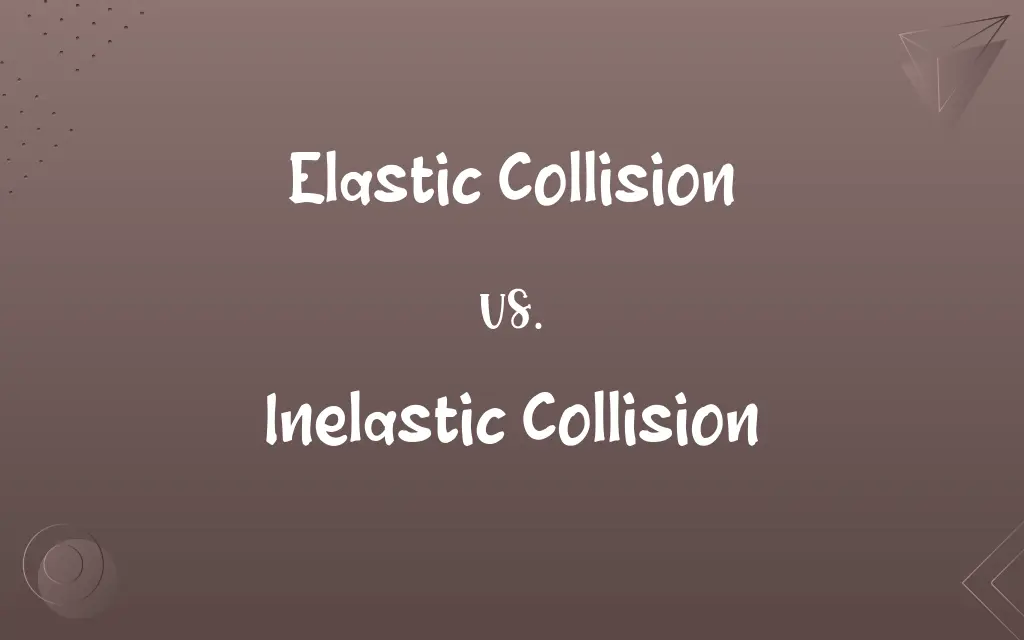Elastic Collision vs. Inelastic Collision: Know the Difference

By Shumaila Saeed || Published on February 28, 2024
Elastic collisions preserve both total kinetic energy and momentum, while inelastic collisions conserve momentum but not kinetic energy.

Key Differences
In an Elastic Collision, both momentum and kinetic energy are conserved. The objects bounce off with no loss in overall kinetic energy. Conversely, in an Inelastic Collision, while momentum remains conserved, kinetic energy is not conserved. Some of it is transformed into other forms of energy, such as heat or sound.
Shumaila Saeed
Feb 28, 2024
During an Elastic Collision, objects collide and return to their original shape with no lasting deformation. The kinetic energy before and after the collision remains the same. On the other hand, Inelastic Collisions often result in objects becoming deformed or stuck together, indicating a loss of kinetic energy.
Shumaila Saeed
Feb 28, 2024
Elastic Collisions are idealized scenarios, common in theoretical physics, but less often observed in real-world situations. In these collisions, the sum of the kinetic energies of the objects before collision equals the sum after collision. In Inelastic Collisions, part of the kinetic energy is converted into other forms of energy, which is why these are more commonly observed in everyday situations.
Shumaila Saeed
Feb 28, 2024
In Elastic Collisions, the objects do not stick together but rebound off each other. This is typical in billiard balls or gas molecules. In contrast, Inelastic Collisions often result in the colliding objects sticking together or changing shape, as seen in a car crash where the vehicles may crumple and join together.
Shumaila Saeed
Feb 28, 2024
Elastic Collisions are characterized by a total conservation of mechanical energy. They are exemplified in systems like pendulums or atomic particles. Inelastic Collisions, however, are characterized by a partial loss of the system's mechanical energy. This energy is not destroyed but transformed, as seen in sports like football or rugby, where collisions are frequent.
Shumaila Saeed
Feb 28, 2024
ADVERTISEMENT
Comparison Chart
Energy Conservation
Total kinetic energy is conserved
Kinetic energy is not conserved
Shumaila Saeed
Feb 28, 2024
Physical Deformation
No permanent deformation
Permanent deformation or objects stick together
Shumaila Saeed
Feb 28, 2024
Energy Transformation
No transformation of kinetic energy
Kinetic energy is partly converted to other energy forms
Shumaila Saeed
Feb 28, 2024
ADVERTISEMENT
Elastic Collision and Inelastic Collision Definitions
Elastic Collision
A collision where objects rebound without lasting deformation.
In an elastic collision, the rubber balls bounced back to their original shape and speed.
Shumaila Saeed
Jan 19, 2024
Inelastic Collision
A collision resulting in deformation or sticking together.
In the inelastic collision, the clay balls stuck together, losing their individual shapes.
Shumaila Saeed
Jan 19, 2024
Elastic Collision
A collision in which kinetic energy is conserved.
The billiard balls exhibited an elastic collision, bouncing off each other without losing speed.
Shumaila Saeed
Jan 19, 2024
Inelastic Collision
A collision where some kinetic energy is lost to other forms.
The inelastic collision of the football players resulted in energy dissipation through sound and heat.
Shumaila Saeed
Jan 19, 2024
Elastic Collision
An ideal collision with total energy and momentum conservation.
The elastic collision between the particles in the gas preserved their total energy and momentum.
Shumaila Saeed
Jan 19, 2024
ADVERTISEMENT
Inelastic Collision
A collision where kinetic energy is not conserved.
The car crash was an inelastic collision, as the kinetic energy was partly converted to heat and sound.
Shumaila Saeed
Jan 19, 2024
Elastic Collision
A collision in which no energy is converted to other forms.
The elastic collision of atoms in a perfect gas involves no energy loss to heat.
Shumaila Saeed
Jan 19, 2024
Inelastic Collision
A real-world collision with energy transformation.
During the inelastic collision, the crumpling of the metal absorbed some of the vehicles' kinetic energy.
Shumaila Saeed
Jan 19, 2024
Elastic Collision
A perfectly efficient collision with no kinetic energy loss.
The pendulum demonstrated an elastic collision, swinging back with undiminished energy.
Shumaila Saeed
Jan 19, 2024
Inelastic Collision
A collision in which objects do not rebound perfectly.
The inelastic collision between the two soft toys resulted in them slowly separating after impact.
Shumaila Saeed
Jan 19, 2024
Repeatedly Asked Queries
What is conserved in an elastic collision?
Both momentum and kinetic energy are conserved in an elastic collision.
Shumaila Saeed
Feb 28, 2024
Are elastic collisions common in everyday life?
Elastic collisions are less common in everyday life and more idealized.
Shumaila Saeed
Feb 28, 2024
Do objects change shape permanently in an elastic collision?
No, objects do not undergo permanent deformation in an elastic collision.
Shumaila Saeed
Feb 28, 2024
Can kinetic energy be lost in an elastic collision?
No, kinetic energy is not lost in an elastic collision.
Shumaila Saeed
Feb 28, 2024
Is energy transformed in an elastic collision?
No, there is no transformation of energy in an elastic collision.
Shumaila Saeed
Feb 28, 2024
Do objects change shape in an inelastic collision?
Yes, objects often deform or stick together in an inelastic collision.
Shumaila Saeed
Feb 28, 2024
Can an inelastic collision ever be completely inelastic?
Yes, in a completely inelastic collision, the colliding bodies stick together.
Shumaila Saeed
Feb 28, 2024
Can kinetic energy be lost in an inelastic collision?
Yes, kinetic energy is partially lost in an inelastic collision.
Shumaila Saeed
Feb 28, 2024
Are car crashes examples of elastic or inelastic collisions?
Car crashes are examples of inelastic collisions.
Shumaila Saeed
Feb 28, 2024
Can an elastic collision occur in gases?
Yes, elastic collisions can occur between molecules in gases.
Shumaila Saeed
Feb 28, 2024
What is conserved in an inelastic collision?
Momentum is conserved, but kinetic energy is not conserved in an inelastic collision.
Shumaila Saeed
Feb 28, 2024
Can temperature affect the elasticity of a collision?
Yes, temperature can affect the material properties and thus the nature of a collision.
Shumaila Saeed
Feb 28, 2024
Are inelastic collisions common in everyday life?
Yes, inelastic collisions are more common in everyday situations.
Shumaila Saeed
Feb 28, 2024
Are elastic collisions perfectly efficient?
In theory, yes, as they involve no loss of kinetic energy.
Shumaila Saeed
Feb 28, 2024
Can an object's speed change after an elastic collision?
Yes, while the total kinetic energy is conserved, an object's individual speed can change after an elastic collision.
Shumaila Saeed
Feb 28, 2024
Is energy transformed in an inelastic collision?
Yes, some kinetic energy is transformed into other forms of energy in an inelastic collision.
Shumaila Saeed
Feb 28, 2024
Does an inelastic collision imply total energy loss?
No, total energy is conserved, but kinetic energy is partially transformed.
Shumaila Saeed
Feb 28, 2024
What happens to sound and heat in an inelastic collision?
In an inelastic collision, some kinetic energy may be converted into sound and heat.
Shumaila Saeed
Feb 28, 2024
Is a bouncing ball an example of an elastic collision?
It can be, if the ball rebounds without losing kinetic energy.
Shumaila Saeed
Feb 28, 2024
Are billiard ball collisions typically elastic?
Yes, billiard ball collisions are often considered elastic.
Shumaila Saeed
Feb 28, 2024
Share this page
Link for your blog / website
HTML
Link to share via messenger
About Author
Written by
Shumaila SaeedShumaila Saeed, an expert content creator with 6 years of experience, specializes in distilling complex topics into easily digestible comparisons, shining a light on the nuances that both inform and educate readers with clarity and accuracy.








































































